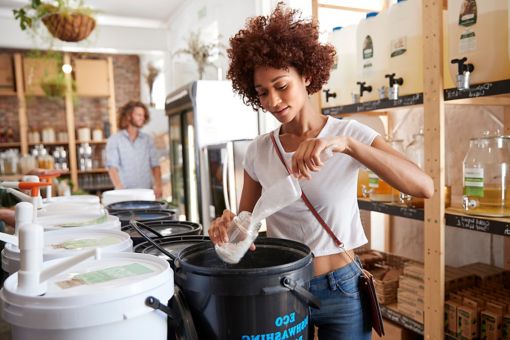As the global shift towards a circular economy accelerates, now is the time for businesses to unlock new opportunities for a more sustainable and prosperous future.
In a world confronted with the urgent realities of finite resources and environmental impact, the need to transition from a linear to a circular economy is more pressing than ever. The consumer goods and retail (C&R) industry, with its substantial reliance on primary raw materials and its significant environmental footprint, has a crucial role to play in this transition.
In this report, we examine the progress of the C&R sector towards circularity. By analyzing six key areas, the report provides a snapshot of the industry's readiness across its different sub-sectors, highlights leading practices, and offers recommendations for accelerating the shift to a circular economy.
From talk to action
Paving the way for a circular economy in the consumer goods and retail industry
Circularity brings significant opportunities for C&R to reimagine the future
Embracing circularity is not just an environmental imperative for C&R businesses — it's a strategic opportunity to unlock new value and build resilience. From the more efficient use of resources, more resilient supply chains, lower operational costs, through to innovative new business models, synergies and collaborations, we believe it’s an opportunity too costly to ignore.
Key recommendations for accelerating circularity
Our research reveals that while many C&R companies have circular ambitions, translating those ambitions into action requires a focused approach. Here are some key recommendations by sub-sector:
- The consumer electronics sector demonstrates strong circularity readiness, ranking first across multiple indicators, highlighting its willingness to embedding circular practices.
- Scaling up existing pilot take-back programs across broader geographies and product categories is crucial for the sector to achieve a more significant and lasting impact and to recover precious raw materials from existing electronic waste.
- Translating ambitious circularity goals into actionable implementation roadmaps and measurable targets will be essential for driving continued progress in the sector.
- The fashion industry demonstrates strong progress in setting ambitious circularity goals and fostering collaboration, but needs to translate these ambitions into broader implementation and tangible outcomes.
- Key opportunities for the sector include improving transparency and traceability of materials, increasing the use of recycled raw materials within the industry, and tackling overproduction through circular business models like rental, resale, and repair.
- Embracing digital product passports, promoting safe material choices, and adopting demand-driven production models will be crucial for advancing circularity in fashion.
- The food and beverage sector excels in collaborative initiatives and communicating a clear circular vision, but faces challenges in improving resource inflow management and reducing food waste at the production and consumption stages.
- Prioritizing regenerative agriculture practices, implementing nature-based solutions to have more resilient supply chains, and rethinking packaging strategies are crucial steps for the sector.
- Educating consumers on waste reduction and leveraging technology to manage supply and demand will be essential for achieving a circular food and beverage industry.
- While demonstrating a commitment to resource efficiency and circular design principles, the furniture sector's progress is hampered by a lack of ambitious targets and limited cross-industry collaboration.
- Furniture companies should prioritize due diligence in sourcing sustainable materials, explore new production and sales models that emphasize durability and reuse, and actively participate in sectoral coalitions to advance circularity.
- Embracing modular design, promoting furniture-as-a-service models, and strengthening Extended Producer Responsibility (EPR) programs will be key to unlocking circularity in the furniture sector.
- The home & personal care sector has an opportunity to strengthen its circularity ambitions and embrace a more unified approach.
- Simplifying packaging to enhance recyclability, piloting and scaling up take-back programs to to promote circularity, and empowering consumers to adopt circular practices with reusable or refillable items are crucial areas for improvement.
- Standardizing packaging designs, investing in robust collection and recycling infrastructure will be essential for driving circularity in the sector.
- The luxury goods sector is making good progress in setting circular ambitions and piloting circular business models, but can further enhance its performance by strengthening target-setting, collaboration, and circular design practices.
- Luxury brands should prioritize the responsible sourcing of raw materials, leverage technology to enhance transparency and traceability, and fully integrate circular targets into their business strategies.
- Embracing longevity and repairability as brand attributes, and capitalizing on the growing pre-owned market will be key to advancing circularity in the luxury goods sector.
- While demonstrating progress in setting circular goals and engaging in collaborative initiatives, the retail sector faces challenges in improving resource inflow management and fully embracing circular product offerings.
- Retailers should prioritize the design and promotion of circular products and further explore innovative business models that extend product and packaging lifecycles.
- Collaborating with suppliers to enhance product sustainability, educating consumers on circular practices, and embracing digital technologies to optimize resource use and reduce waste will be crucial for advancing circularity in retail.
How KPMG can help
Circular economy strategy development:
Circular economy strategy development is not a far-fetched goal, but a realistic ambition. We offer expert guidance to define strategies that are sustainable and profitable, ensuring they align with your business objectives, industry context, and market opportunities.
Circular economy measurement and steering:
Effective circularity transformation relies on data-driven insights. We provide the tools and sector expertise to help you track your circular performance, measure impact, and make informed decisions to optimize your strategy.
Operational Transformation:
Translating circular ambitions into operational reality is a challenge that requires a structured approach. Our execution and delivery services simplify the complexity of adopting circular practices, helping you transform your operations, engage your supply chain, and embed circular practices into your business DNA.
Circular maturity assessments:
Understanding your starting point can be crucial for effective circular transformation. Leveraging our robust assessment framework, we provide tailored circular maturity readiness assessments that pinpoint strengths, identify risks and opportunities, and chart a clear path forward on your circularity journey.
Explore
Get in touch
Connect with us
- Find office locations kpmg.findOfficeLocations
- kpmg.emailUs
- Social media @ KPMG kpmg.socialMedia
Stay up to date with what matters to you
Gain access to personalized content based on your interests by signing up today




